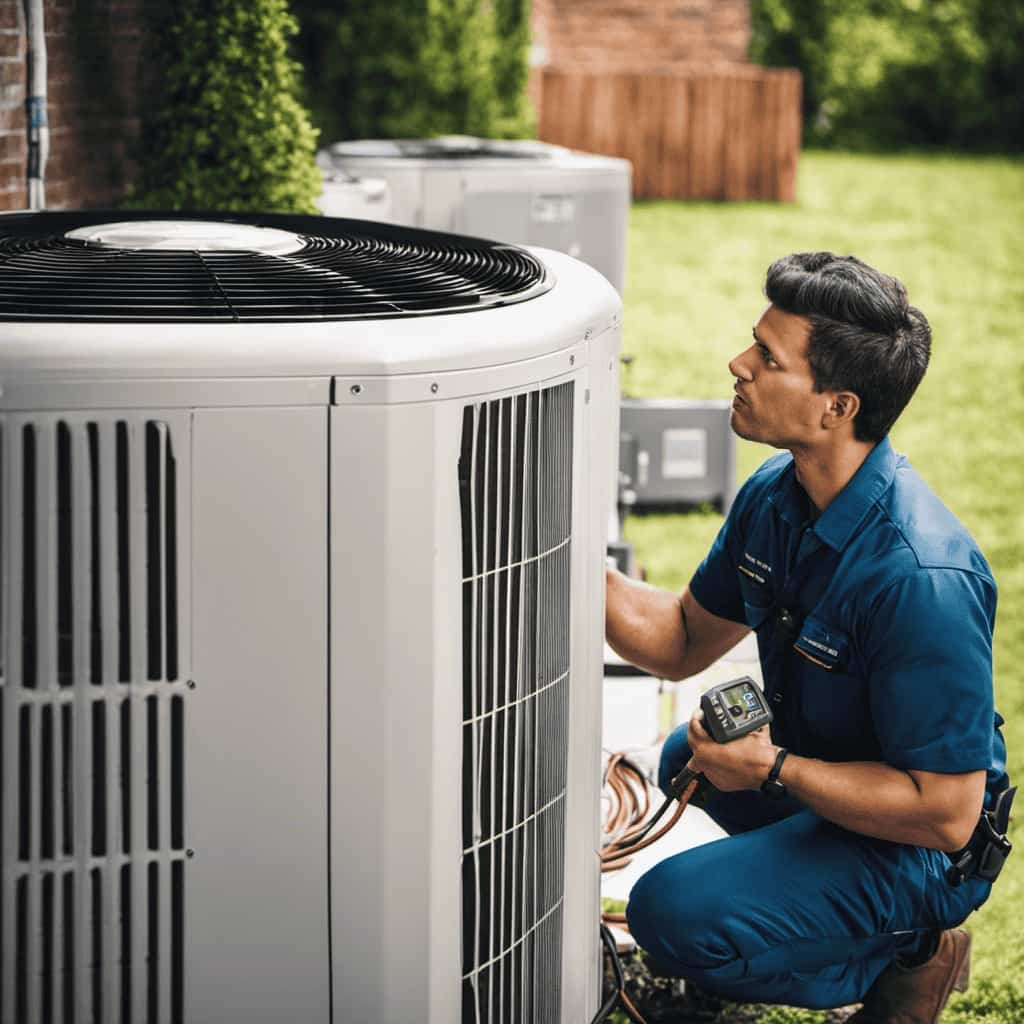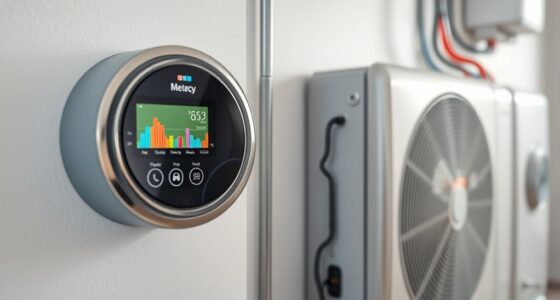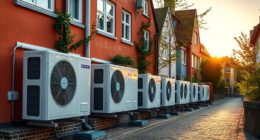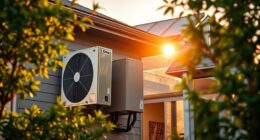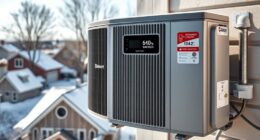Are you prepared to enhance the efficiency of your geothermal heat pump? We’ve got everything you need.
In this article, we’ll show you how to optimize your system’s performance and maximize energy savings. From correctly sizing your GSHP system to enhancing heat transfer efficiency, we’ll provide you with the technical know-how to make the most of your geothermal energy.
So, let’s dive in and start serving up some serious energy efficiency!
Key Takeaways
- Proper sizing of ground source heat pump systems is crucial for maximizing efficiency and meeting heating and cooling demands.
- Optimizing ground loop placement and heat transfer efficiency through loop depth and spacing, soil composition analysis, insulation, and regular maintenance enhances the performance of the system.
- Selecting the right heat pump unit based on heating and cooling requirements, size, and efficiency, along with proper insulation, is important for optimal performance.
- Optimizing thermostat settings, utilizing programmable thermostats, implementing energy-saving strategies like zoning and regular maintenance, and utilizing geothermal energy for hot water contribute to maximizing ground source heat pump efficiency.
Understanding Ground Source Heat Pumps
We frequently use ground source heat pumps to efficiently heat and cool our homes. These systems are designed to take advantage of the Earth’s constant temperature to provide energy-efficient heating and cooling.
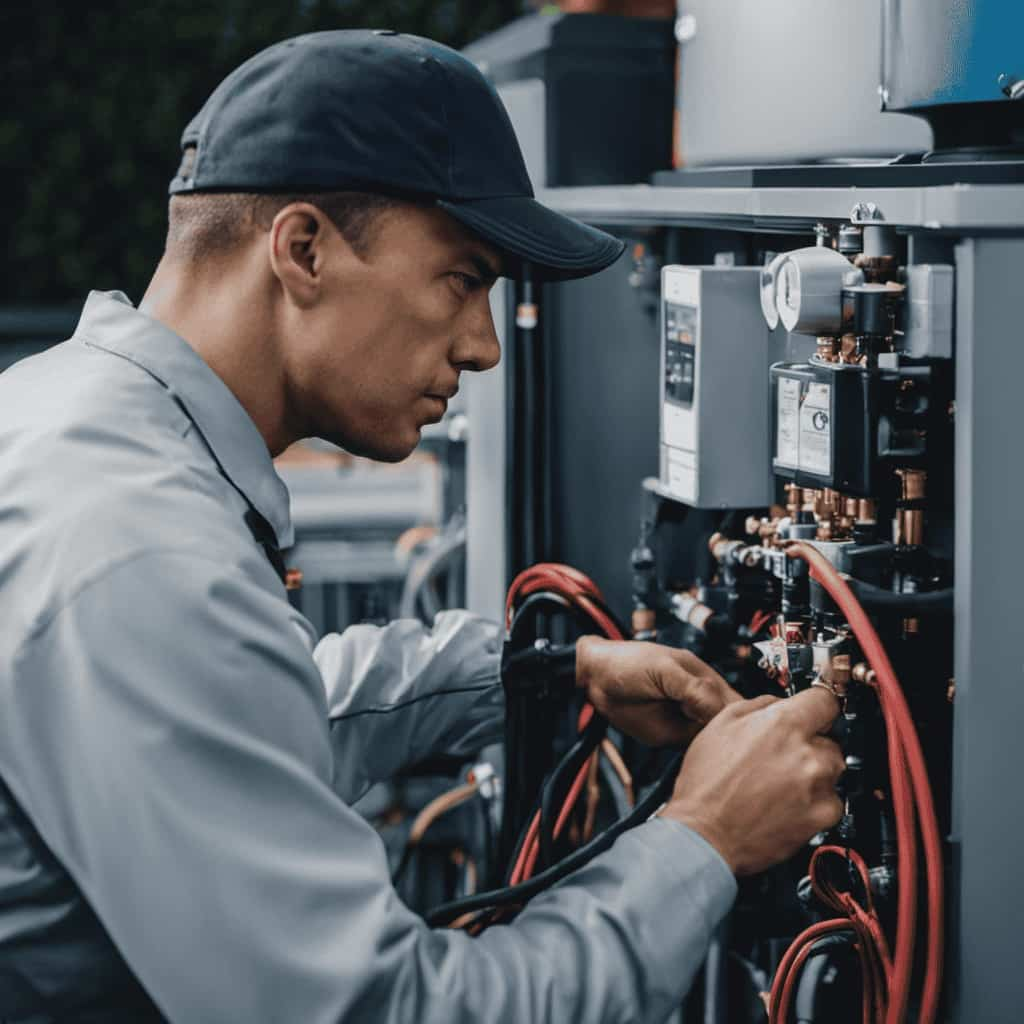
When considering the sizing of a ground source heat pump system, there are several factors to take into account. The first consideration is the size of the home or building that needs to be heated or cooled. A larger space will require a larger heat pump system to adequately meet the heating and cooling demands.
Additionally, the climate of the region plays a role in determining the appropriate size of the system. Cold climates will require a larger system to provide sufficient heating, while warmer climates may require a smaller system.
By considering these sizing considerations, we can ensure that the ground source heat pump system is energy-efficient and effectively serves our needs.
Now, let’s dive into the importance of sizing your gshp system correctly.
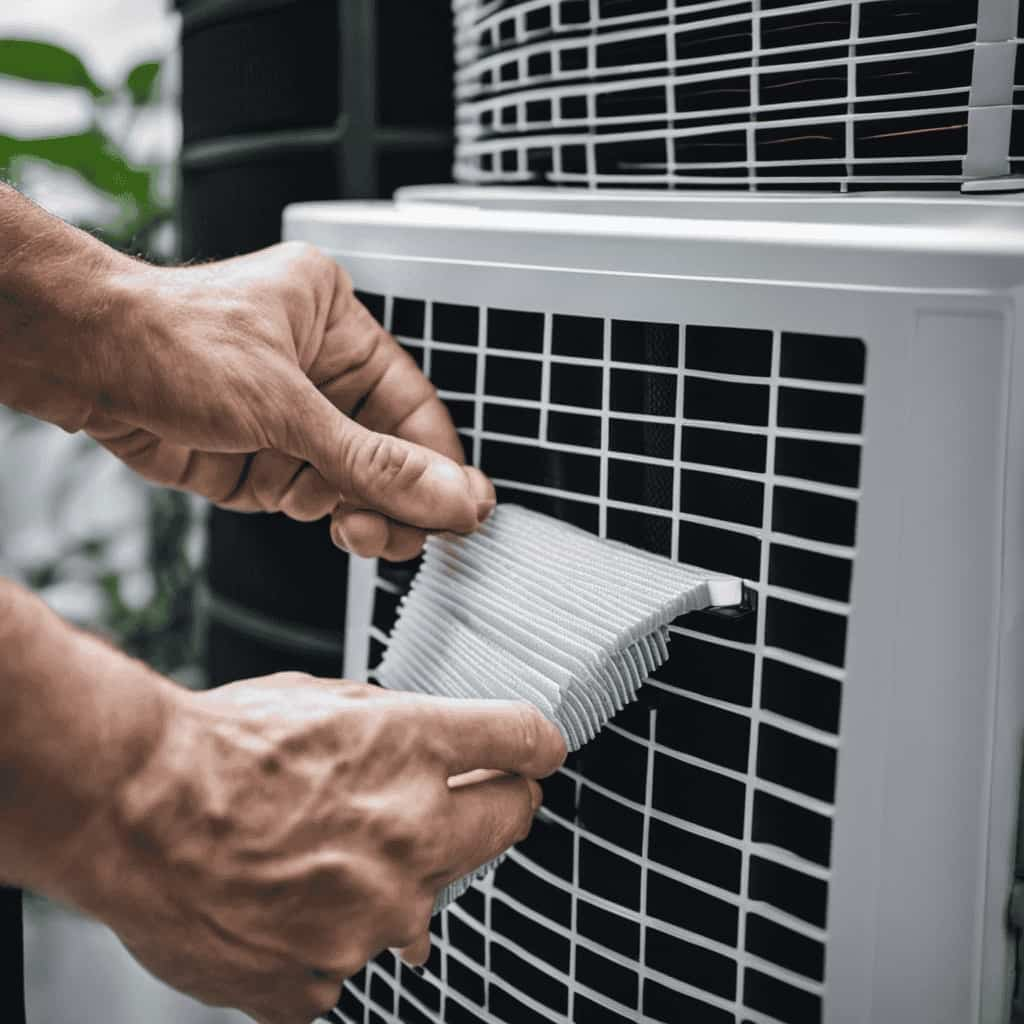
Sizing Your GSHP System Correctly
When it comes to optimizing the efficiency of a ground source heat pump (GSHP) system, one crucial aspect is ensuring that the system is properly sized. Proper sizing is essential to ensure that the system can effectively meet the heating and cooling demands of the building.
However, there are common mistakes that can occur during the sizing process, which can lead to inefficiencies and decreased performance of the GSHP system.
Importance of Proper Sizing
Properly sizing your GSHP system is crucial for maximizing its efficiency. When it comes to ground source heat pumps (GSHPs), size matters. Here are three reasons why proper sizing is important:
Optimal Performance: An appropriately sized GSHP system ensures that it operates at its peak performance, providing sufficient heating and cooling capacity for your space. Undersized systems may struggle to meet the demand, leading to discomfort and reduced efficiency, while oversized systems can cycle on and off frequently, wasting energy and increasing wear and tear.
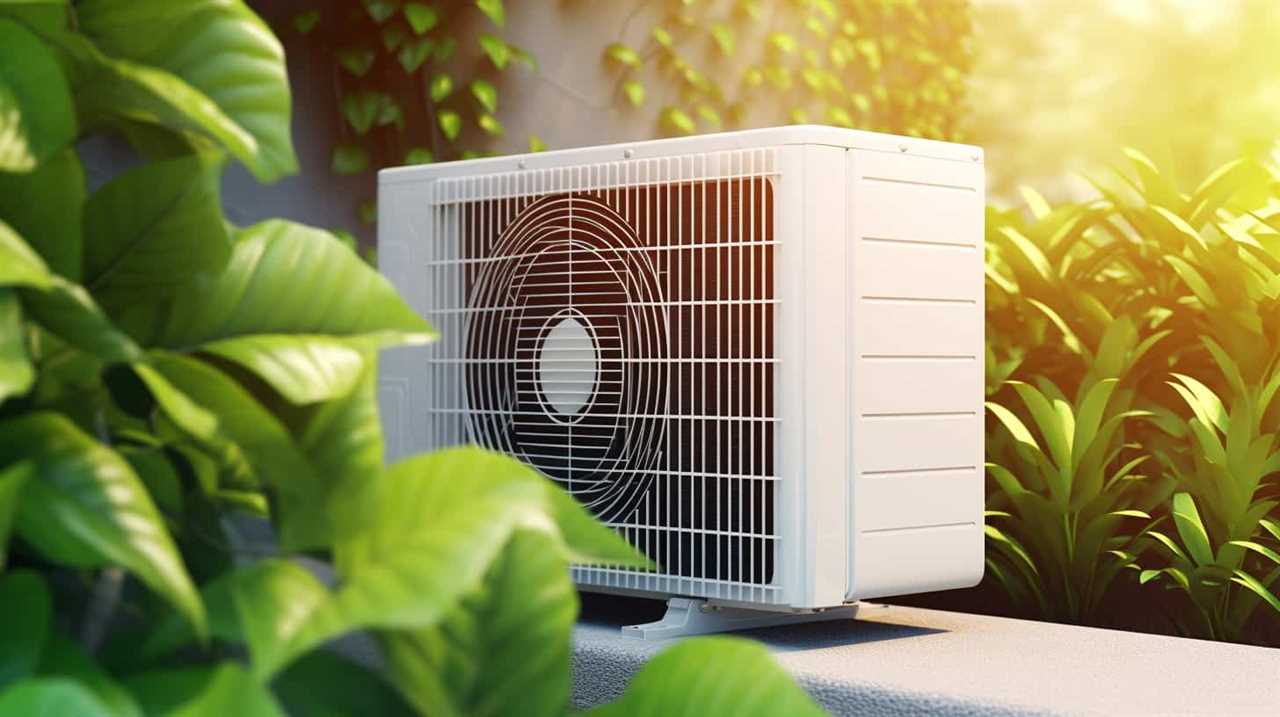
Energy Efficiency: By sizing your GSHP system correctly, you can avoid unnecessary energy consumption. A properly sized system will run more efficiently, reducing your energy bills and environmental impact.
Maximizing Incentives: Many energy efficiency incentives and rebates require proper installation techniques, including accurate sizing. By ensuring your GSHP system is correctly sized, you can take advantage of these incentives and save even more money.
Common Sizing Mistakes
One common mistake in sizing GSHP systems is failing to consider future changes in heating and cooling needs.
When sizing a ground source heat pump (GSHP) system, it’s crucial to account for potential alterations in the building’s requirements over time. Neglecting to do so can lead to an undersized system that fails to meet the heating and cooling demands of the occupants.

To avoid this pitfall, it’s essential to employ common sizing techniques that take into account factors such as insulation levels, building orientation, and occupancy patterns. By accurately sizing the GSHP system, we can ensure that it operates at its peak efficiency, maximizing energy savings and reducing environmental impact.
Proper sizing also allows for potential expansions or modifications to the building in the future, without the need for costly system upgrades.
As we delve into the next section on optimizing the placement of ground loops, we’ll explore how correct sizing plays a crucial role in achieving optimal system performance.
Optimizing the Placement of Ground Loops
When optimizing the placement of ground loops for our ground source heat pump system, there are several key points to consider.

First, loop depth and spacing play a crucial role in the efficiency of the system. By placing the loops at an optimal depth and spacing, we can maximize heat exchange with the ground.
Additionally, the composition and temperature of the soil should be taken into account, as they can affect the thermal conductivity and performance of the system.
Loop Depth and Spacing
Our team has found that optimizing the depth and spacing of ground loops is crucial for maximizing the efficiency of ground source heat pump systems. The loop depth optimization and loop spacing analysis are two key factors to consider when designing a ground loop system.
Here are three important points to keep in mind:

- Loop Depth Optimization
- Determine the optimal depth for the ground loops based on soil conditions and heat transfer requirements.
- Deeper loops can take advantage of more stable ground temperatures, but may require longer pipe lengths.
- Shallower loops may be more cost-effective, but could be affected by seasonal temperature variations.
- Loop Spacing Analysis
- Calculate the appropriate spacing between ground loops to ensure efficient heat transfer.
- Closer spacing allows for better heat exchange, but may require more loops and increased installation costs.
- Wider spacing can lead to reduced efficiency and potential heat loss.
Soil Composition and Temperature
To achieve optimal performance of our ground source heat pump system, it is essential to consider the soil composition and temperature when optimizing the placement of ground loops. The soil composition affects the moisture content, which in turn can impact the efficiency of the heat pump. Soils with higher moisture content provide better heat transfer, as water has higher thermal conductivity than air. Additionally, the thermal conductivity of the soil plays a crucial role in heat pump efficiency. Soils with higher thermal conductivity allow for better heat transfer between the ground and the heat pump system. By understanding the soil moisture and thermal conductivity of the soil, we can strategically place the ground loops to maximize heat transfer and overall system efficiency.
| Soil Composition | Impact on Heat Pump Efficiency |
|---|---|
| High moisture content | Better heat transfer due to higher thermal conductivity of water |
| High thermal conductivity | Enhanced heat transfer between ground and heat pump system |
| Low moisture content | Reduced heat transfer and potential system inefficiency |
| Low thermal conductivity | Limited heat transfer and decreased system efficiency |
Understanding the relationship between soil composition, moisture content, and thermal conductivity is crucial in optimizing the placement of ground loops for maximum heat pump efficiency.
Enhancing Heat Transfer Efficiency
We can improve heat transfer efficiency by implementing various techniques. To enhance the performance and achieve energy savings, consider the following:
Optimizing fluid flow: Properly sizing and designing the piping system can minimize pressure drops and increase flow rates, enhancing heat transfer efficiency.
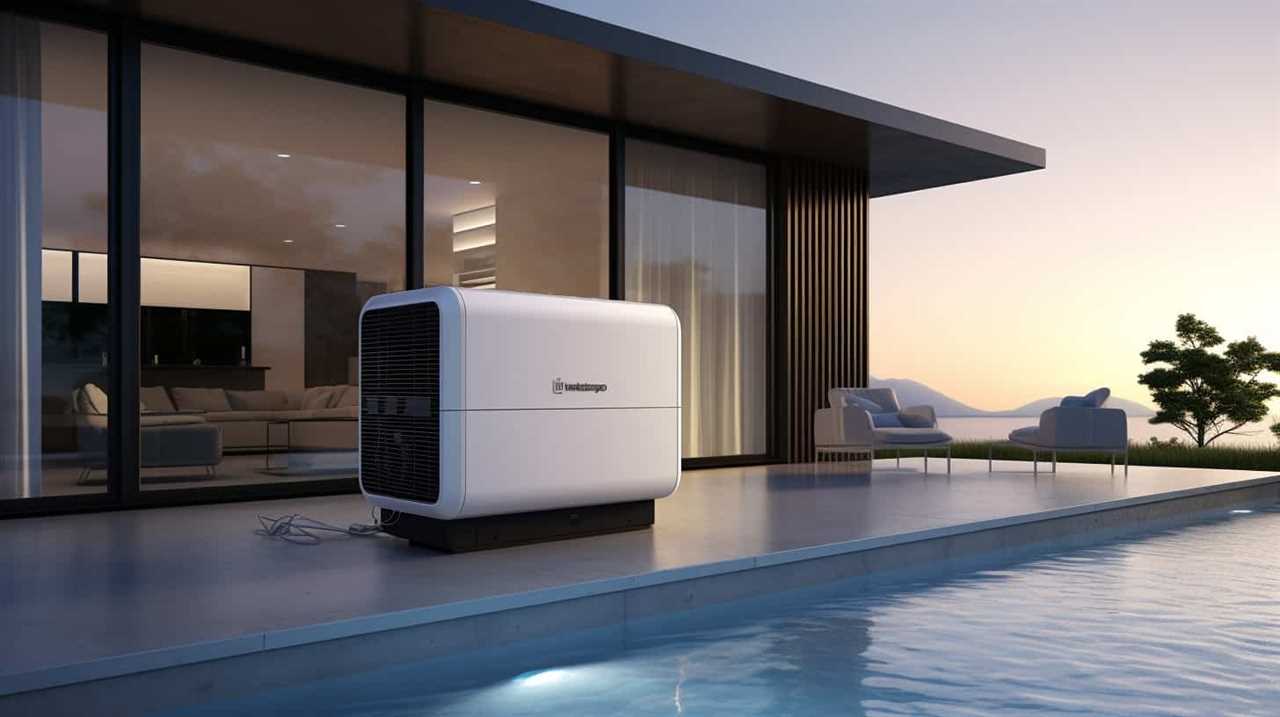
Utilizing heat exchangers: Installing heat exchangers can facilitate heat transfer between the ground loop fluid and the refrigerant, improving overall system efficiency.
Enhancing thermal conductivity: Using high-quality, thermally conductive materials for the ground loop piping can maximize heat transfer efficiency and reduce energy consumption.
Selecting the Right Heat Pump Unit
When selecting the right heat pump unit, we should consider both the heating and cooling requirements, as well as the size and efficiency of the unit. It is important to choose a heat pump that meets the specific needs of your space while also being energy-efficient. To help you make an informed decision, consider the following factors:
| Heating Capacity | Cooling Capacity |
|---|---|
| 2 tons | 2.5 tons |
| 3 tons | 3.5 tons |
| 4 tons | 4.5 tons |
| 5 tons | 5.5 tons |
| 6 tons | 6.5 tons |
In addition to selecting the right size, regular heat pump maintenance is crucial to ensure optimal performance and energy savings. Some energy-saving tips for heat pump maintenance include cleaning or replacing air filters regularly, checking and cleaning the outdoor coils, and scheduling professional inspections at least once a year. By taking care of your heat pump and following these energy-saving tips, you can maximize its efficiency and enjoy lower energy bills.

To further enhance the efficiency of your ground source heat pump system, proper insulation is essential.
Proper Insulation for Maximum Efficiency
When it comes to maximizing the efficiency of a ground source heat pump system, proper insulation plays a crucial role.
First, the selection of the right insulation material is essential in minimizing heat loss and ensuring optimal performance.
Additionally, implementing effective air sealing techniques helps to prevent air leakage, reducing energy waste.
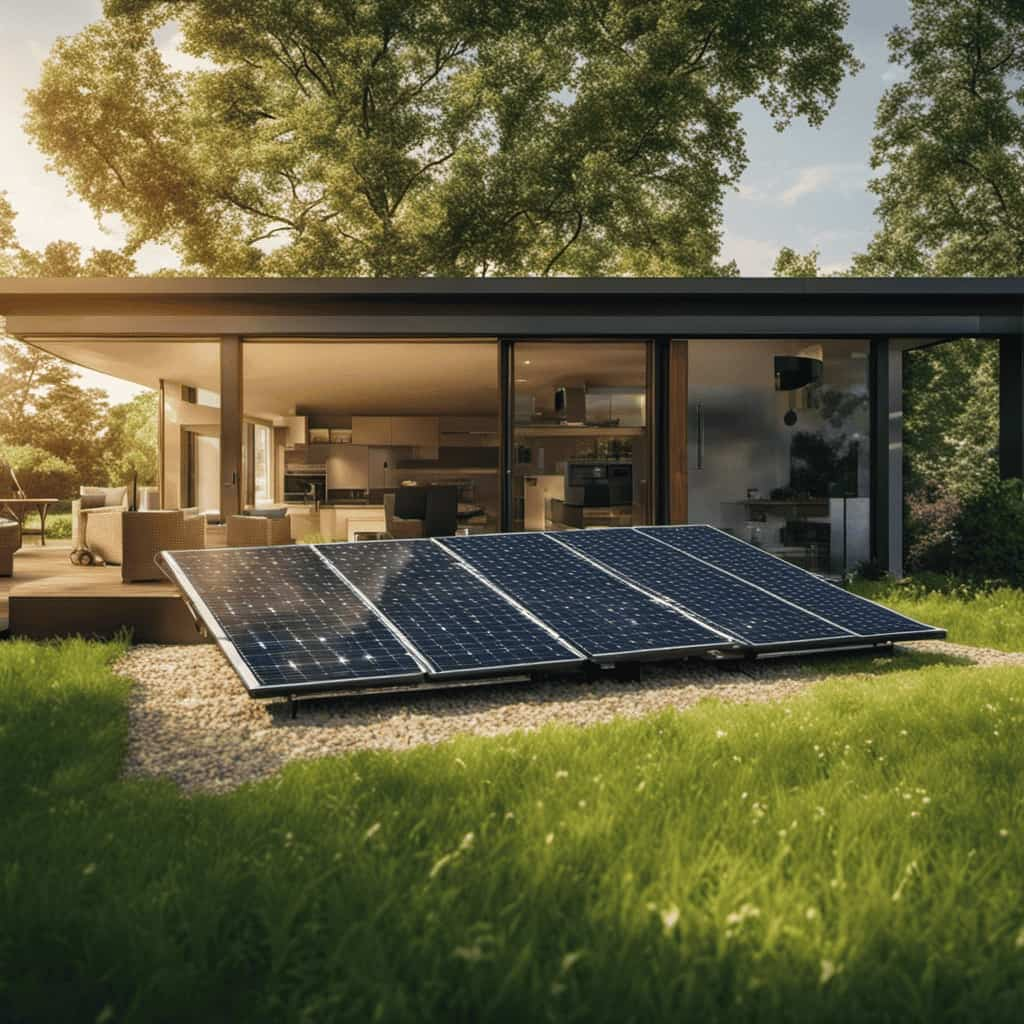
Lastly, addressing thermal bridging issues is important to eliminate heat transfer through structural components, further improving overall efficiency.
Insulation Material Selection
The proper insulation material selection is essential for maximizing the efficiency of a ground source heat pump. When it comes to choosing the right insulation material, there are several factors to consider.
Here are some tips to help you make an informed decision:
Insulation material comparison:
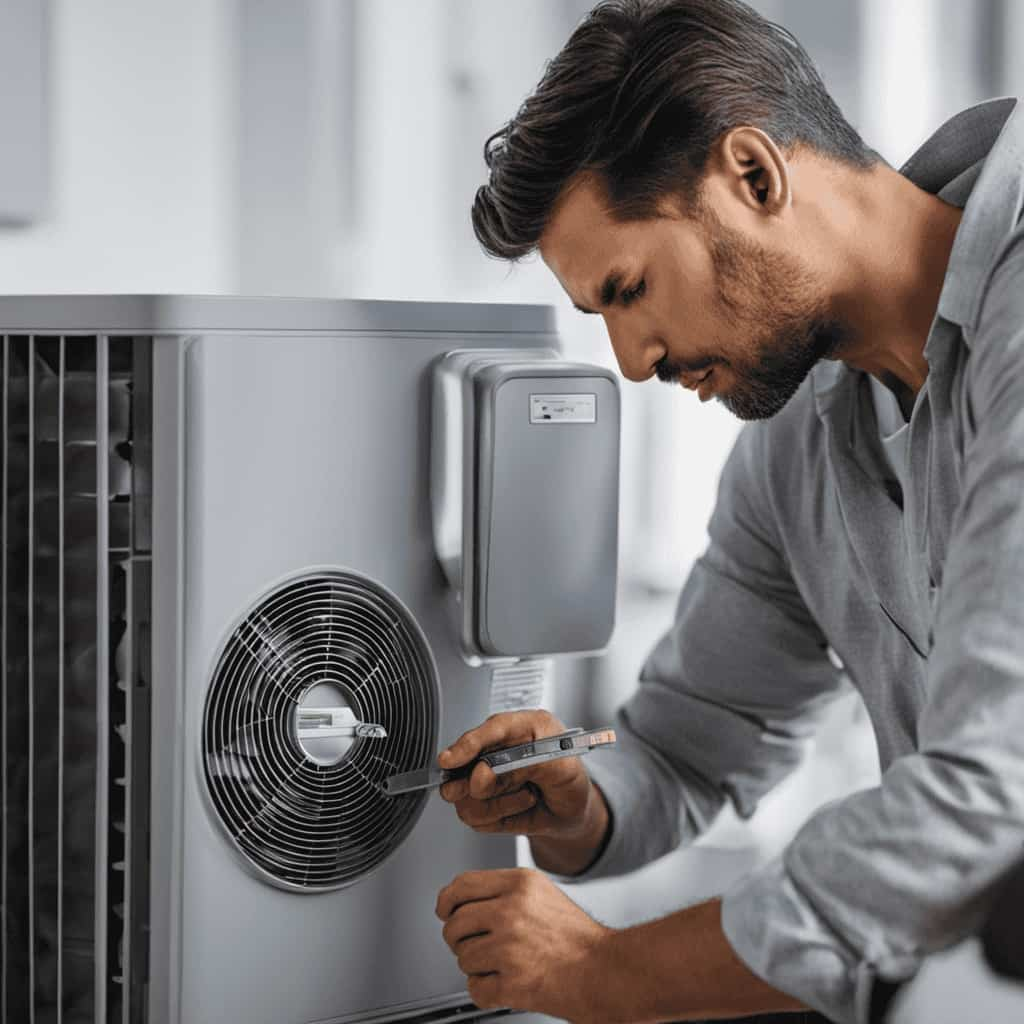
Conductivity: Look for materials with low thermal conductivity to minimize heat loss.
R-value: Consider the insulation material’s R-value, which measures its ability to resist heat flow. Higher R-values indicate better insulation performance.
Moisture resistance: Choose materials that are resistant to moisture to prevent degradation and maintain insulation effectiveness.
Insulation installation tips:
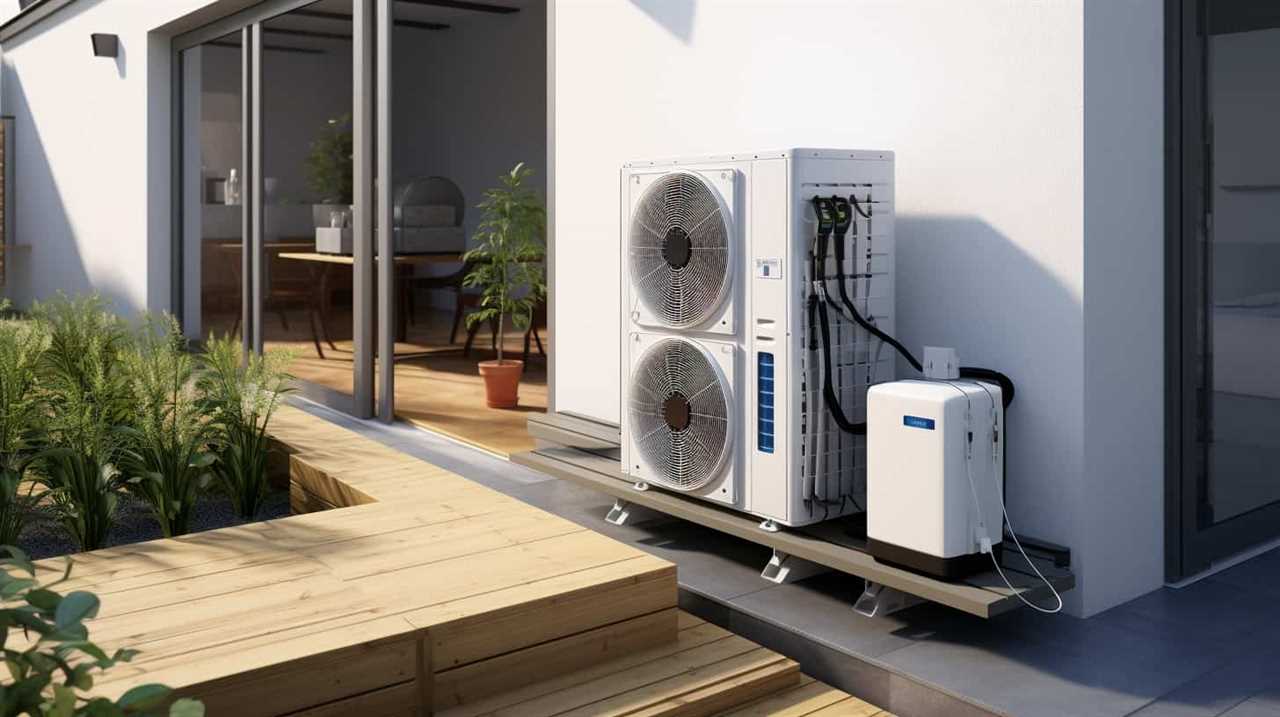
Proper installation: Ensure that the insulation material is installed correctly, with no gaps or voids that can allow heat transfer.
Adequate thickness: Install insulation with the appropriate thickness to provide sufficient thermal resistance.
Vapor barrier: Include a vapor barrier to prevent moisture infiltration and maintain insulation performance.
Air Sealing Techniques
To achieve maximum efficiency, we must implement proper insulation and air sealing techniques. Air sealing techniques are crucial in optimizing the performance of a ground source heat pump system. By effectively sealing air leaks in a building, we can prevent the wastage of heated or cooled air, ensuring that the desired temperature is maintained with minimal energy consumption. Moisture control strategies are also important in air sealing, as excess moisture can lead to mold growth and compromised indoor air quality. To help you understand the significance of air sealing techniques, here is a table showcasing common areas of air leakage and recommended solutions:
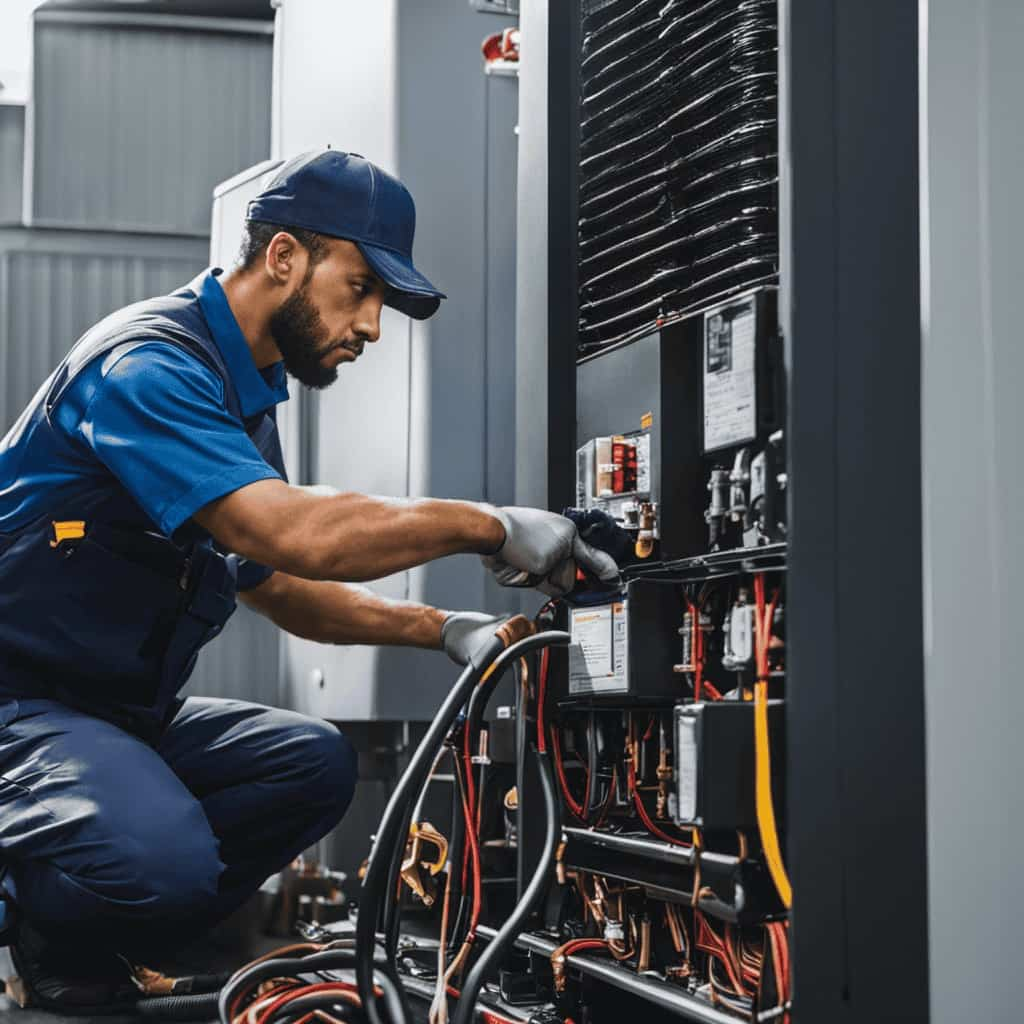
| Area of Air Leakage | Recommended Solution |
|---|---|
| Windows and Doors | Weatherstripping |
| Attic and Basement | Caulking |
| Electrical Outlets | Outlet Gaskets |
Thermal Bridging Prevention
For optimal efficiency, we need to address thermal bridging prevention through proper insulation techniques. This is crucial for reducing heat loss or gain through building materials and ensuring energy savings.
Here are three energy-saving strategies to prevent thermal bridging:
Continuous Insulation: Install a continuous layer of insulation around the entire building envelope to minimize thermal bridging. This helps maintain a consistent temperature inside the building and reduces the need for excessive heating or cooling.
Insulated Cladding Systems: Utilize insulated cladding systems that provide an additional layer of insulation to the building’s exterior. These systems reduce thermal bridging and enhance energy efficiency.

Thermal Breaks: Incorporate thermal breaks in structural components, such as walls or floors, to prevent heat transfer through solid materials. By interrupting the thermal bridge, these breaks help maintain a comfortable indoor environment while reducing energy consumption.
Optimizing the Thermostat Settings
Our goal is to optimize the thermostat settings for maximum efficiency. One important factor in achieving this is thermostat calibration. It’s crucial to ensure that the thermostat accurately measures and maintains the desired temperature. Regular calibration will help prevent any discrepancies in temperature control, leading to improved efficiency.
Another aspect to consider is temperature control. By setting the thermostat to the most appropriate temperature for the specific time of day and season, energy consumption can be minimized. For example, during the winter, setting the thermostat to a lower temperature when you’re away from home can significantly reduce energy usage. Additionally, utilizing programmable thermostats can enable you to schedule temperature adjustments according to your daily routine.
Optimizing thermostat settings through calibration and temperature control can greatly enhance the efficiency of your ground source heat pump system.
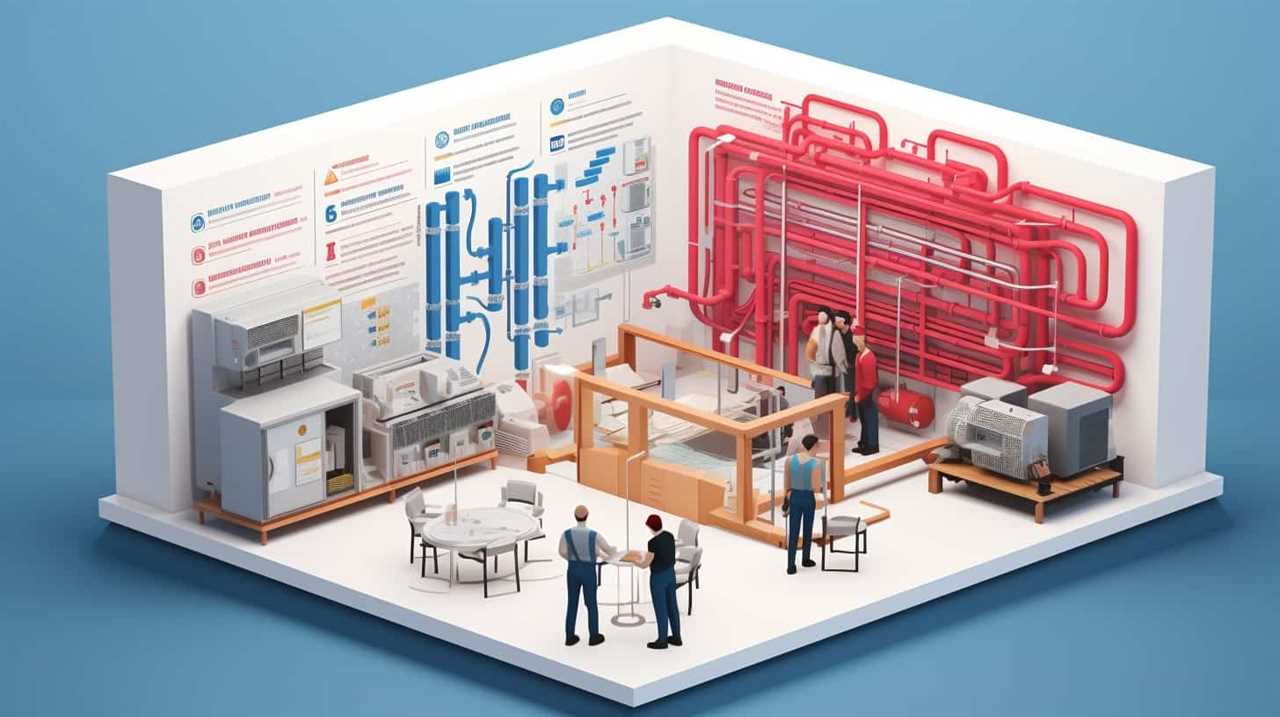
Utilizing Geothermal Energy for Hot Water
Can we use geothermal energy to heat our hot water, and if so, how can we optimize its efficiency?
The answer is yes, geothermal energy can be utilized for hot water heating through geothermal heat pump systems. Here are three ways to optimize its efficiency:
Proper system sizing: Ensuring that the geothermal heat pump system is properly sized for the hot water demand is crucial. Undersized systems may struggle to meet the required hot water needs, while oversized systems can lead to unnecessary energy consumption.
Efficient heat exchangers: Utilizing high-efficiency heat exchangers can enhance the transfer of heat between the geothermal energy source and the hot water supply, maximizing the system’s overall efficiency.

Temperature control strategies: Implementing temperature control strategies, such as using programmable thermostats or timers, can help regulate the hot water temperature and reduce energy waste.
Implementing Zoning and Programmable Controls
We can optimize the efficiency of our ground source heat pump system by implementing zoning and programmable controls. Zoning benefits allow us to divide our space into different zones and control the temperature independently in each zone. This ensures that we are only heating or cooling the areas that are being used, saving energy and improving comfort. Programmable controls implementation allows us to set schedules for heating and cooling based on our occupancy patterns. We can program the system to lower the temperature when no one is present and raise it before we arrive, saving energy without sacrificing comfort. By implementing zoning and programmable controls, we can maximize the efficiency of our ground source heat pump system and enjoy the benefits of lower energy bills and increased comfort.
| Zoning Benefits | Programmable Controls Implementation |
|---|---|
| Energy savings | Increased comfort |
| Improved control | Convenience |
| Reduced wear and | Flexibility to adapt to changing |
| tear on equipment | schedules |
| Enhanced | Environmental stewardship |
| comfort |
Regular Maintenance for Peak Performance
Regular maintenance is essential for ensuring peak performance of ground source heat pumps. It’s important to follow a regular maintenance checklist to keep your system running smoothly. Here are some key points to consider:
- Clean and inspect the filters regularly to ensure proper airflow and prevent dirt buildup.
- Check and adjust the refrigerant levels to optimize system efficiency.
- Inspect and clean the coils to remove any debris or dirt that may hinder heat transfer.
Troubleshooting common issues is also crucial for maintaining optimal performance. Here are some common problems to watch out for:
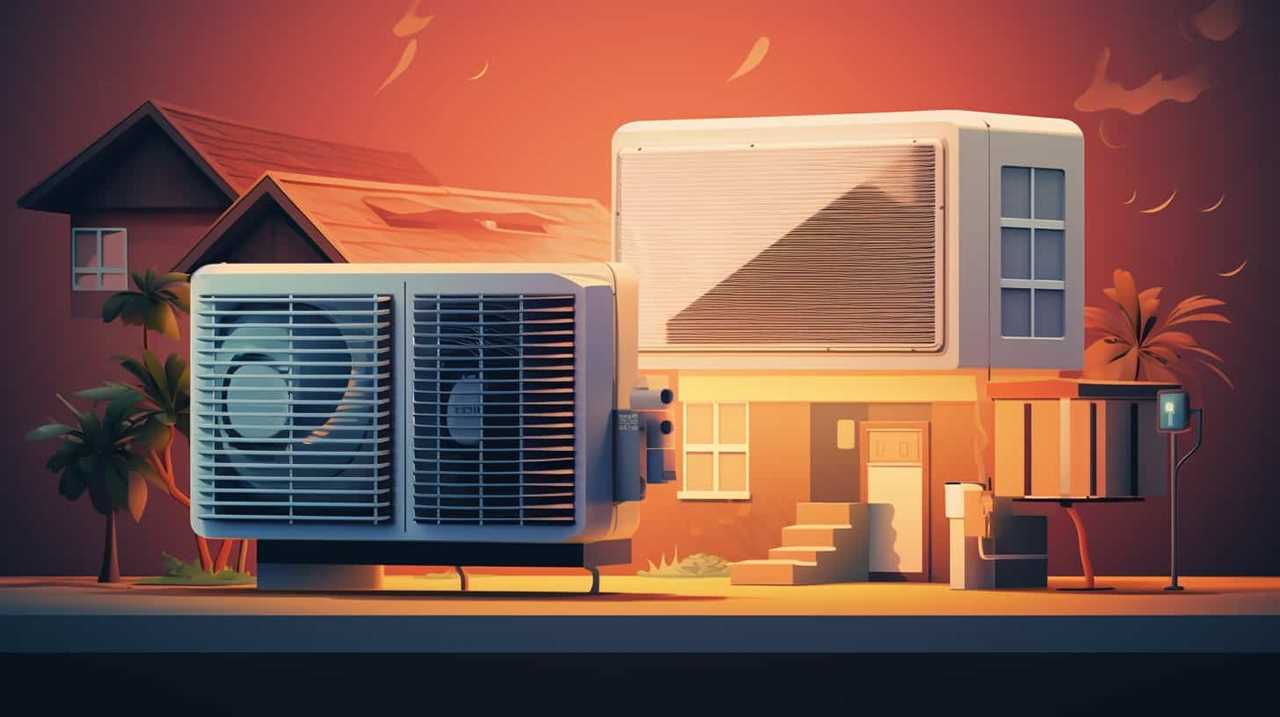
- Insufficient heating or cooling: Check the thermostat settings and ensure the system is properly sized for the space.
- Inadequate airflow: Clean or replace the air filters, and inspect the ductwork for any obstructions or leaks.
- Strange noises or vibrations: Check for loose components and ensure that the system is securely fastened.
Monitoring and Analyzing Energy Consumption
We should track and evaluate our energy consumption to understand the efficiency of our ground source heat pump system. Energy usage tracking allows us to monitor the amount of energy consumed by the system on a regular basis.
By recording and analyzing this data, we can identify patterns and trends that can help us optimize the performance of our heat pump. Energy consumption analysis involves examining the data to identify areas of high energy usage and potential inefficiencies.
This analysis can help us identify opportunities for improvement, such as adjusting system settings or implementing energy-saving measures. By consistently monitoring and analyzing our energy consumption, we can make informed decisions to optimize the efficiency of our ground source heat pump system and reduce our overall energy usage.
Frequently Asked Questions
Can a Ground Source Heat Pump System Be Installed in Any Type of Building or Is It Limited to Certain Structures?
Ground source heat pump systems can be installed in various types of buildings, but there are installation requirements and cost considerations to keep in mind. Certain structures may require additional modifications or have higher installation costs.
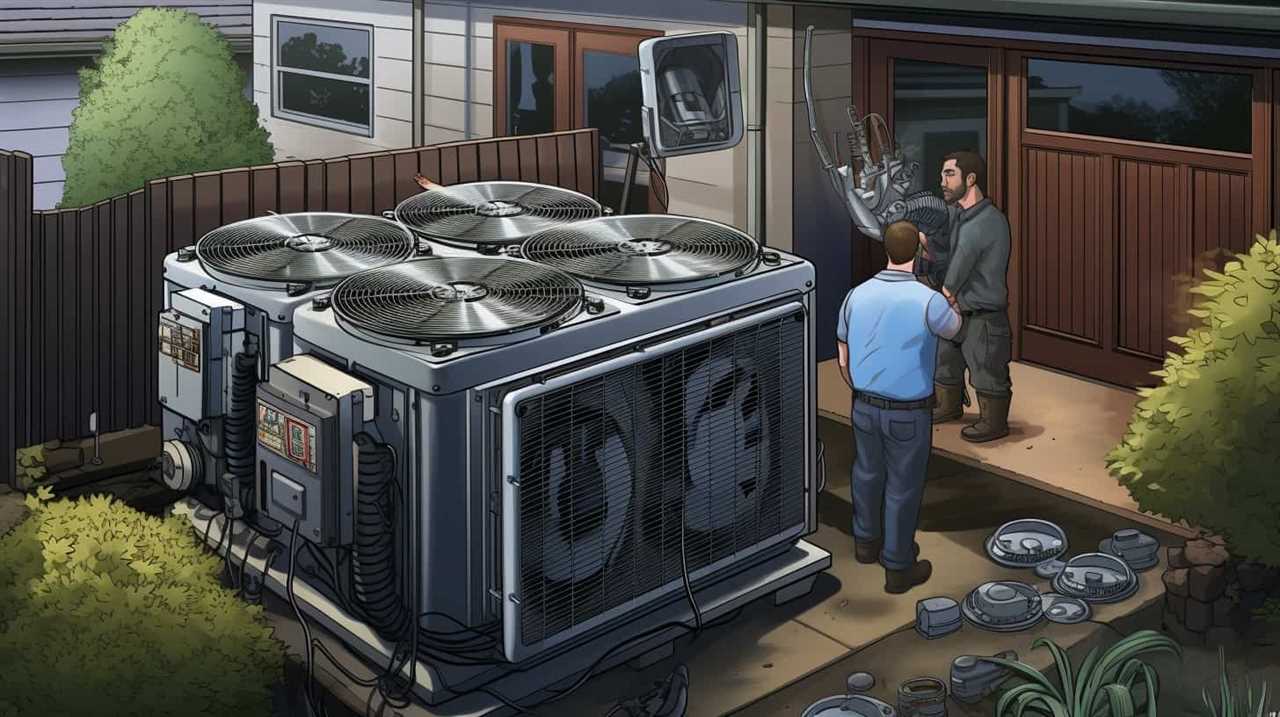
How Long Does It Typically Take to Install a Ground Source Heat Pump System and What Does the Installation Process Involve?
Typically, it takes a certain amount of time to install a ground source heat pump system. The installation process involves various steps that we’ll explain in detail to optimize efficiency.
Are There Any Government or Local Incentives Available for Installing a Ground Source Heat Pump System?
There are government incentives available for installing a ground source heat pump system, such as renewable energy grants. These incentives aim to promote the use of renewable energy sources and encourage the adoption of heat pumps.
Can a Ground Source Heat Pump System Be Used to Cool a Building as Well as Heat It?
Yes, a ground source heat pump system can be used to cool a building as well as heat it. This dual functionality greatly enhances ground source heat pump efficiency and provides numerous benefits for cooling applications.
What Are the Typical Lifespan and Maintenance Requirements of a Ground Source Heat Pump System?
The typical lifespan of a ground source heat pump system depends on regular maintenance. Regular maintenance requirements include checking the refrigerant levels, cleaning the filters, and inspecting the system for any potential issues.

What Are the Most Effective Ways to Improve Ground Source Heat Pump Efficiency?
Improving ground source heat pump efficiency can be achieved through proper system sizing and design, ensuring optimum heat transfer. Conducting regular maintenance, including cleaning air filters and checking refrigerant levels, is crucial. Installing a programmable thermostat can help adjust temperature settings based on occupancy patterns and reduce energy wastage. Proper insulation of the system and the surrounding area also contributes to increased ground source heat pump efficiency. Additionally, considering factors like ground loop depth, orientation, and the heat pump’s coefficient of performance can further enhance its efficiency.
Conclusion
In conclusion, optimizing the efficiency of ground source heat pumps requires careful consideration and strategic planning.
By correctly sizing the system, placing the ground loops in the right location, enhancing heat transfer efficiency, selecting the appropriate heat pump unit, utilizing geothermal energy for hot water, implementing zoning and programmable controls, and regularly maintaining the system, peak performance can be achieved.
Just as a well-tuned orchestra produces a harmonious melody, a well-optimized ground source heat pump system can create a symphony of energy efficiency.
